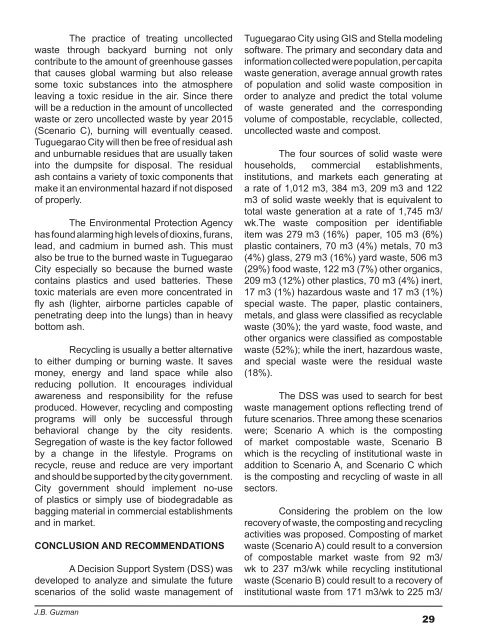download the full article here - EISRJC
download the full article here - EISRJC
download the full article here - EISRJC
Create successful ePaper yourself
Turn your PDF publications into a flip-book with our unique Google optimized e-Paper software.
The practice of treating uncollected<br />
waste through backyard burning not only<br />
contribute to <strong>the</strong> amount of greenhouse gasses<br />
that causes global warming but also release<br />
some toxic substances into <strong>the</strong> atmosp<strong>here</strong><br />
leaving a toxic residue in <strong>the</strong> air. Since <strong>the</strong>re<br />
will be a reduction in <strong>the</strong> amount of uncollected<br />
waste or zero uncollected waste by year 2015<br />
(Scenario C), burning will eventually ceased.<br />
Tuguegarao City will <strong>the</strong>n be free of residual ash<br />
and unburnable residues that are usually taken<br />
into <strong>the</strong> dumpsite for disposal. The residual<br />
ash contains a variety of toxic components that<br />
make it an environmental hazard if not disposed<br />
of properly.<br />
The Environmental Protection Agency<br />
has found alarming high levels of dioxins, furans,<br />
lead, and cadmium in burned ash. This must<br />
also be true to <strong>the</strong> burned waste in Tuguegarao<br />
City especially so because <strong>the</strong> burned waste<br />
contains plastics and used batteries. These<br />
toxic materials are even more concentrated in<br />
fly ash (lighter, airborne p<strong>article</strong>s capable of<br />
penetrating deep into <strong>the</strong> lungs) than in heavy<br />
bottom ash.<br />
Recycling is usually a better alternative<br />
to ei<strong>the</strong>r dumping or burning waste. It saves<br />
money, energy and land space while also<br />
reducing pollution. It encourages individual<br />
awareness and responsibility for <strong>the</strong> refuse<br />
produced. However, recycling and composting<br />
programs will only be successful through<br />
behavioral change by <strong>the</strong> city residents.<br />
Segregation of waste is <strong>the</strong> key factor followed<br />
by a change in <strong>the</strong> lifestyle. Programs on<br />
recycle, reuse and reduce are very important<br />
and should be supported by <strong>the</strong> city government.<br />
City government should implement no-use<br />
of plastics or simply use of biodegradable as<br />
bagging material in commercial establishments<br />
and in market.<br />
CONCLUSION AND RECOMMENDATIONS<br />
A Decision Support System (DSS) was<br />
developed to analyze and simulate <strong>the</strong> future<br />
scenarios of <strong>the</strong> solid waste management of<br />
J.B. Guzman<br />
Tuguegarao City using GIS and Stella modeling<br />
software. The primary and secondary data and<br />
information collected were population, per capita<br />
waste generation, average annual growth rates<br />
of population and solid waste composition in<br />
order to analyze and predict <strong>the</strong> total volume<br />
of waste generated and <strong>the</strong> corresponding<br />
volume of compostable, recyclable, collected,<br />
uncollected waste and compost.<br />
The four sources of solid waste were<br />
households, commercial establishments,<br />
institutions, and markets each generating at<br />
a rate of 1,012 m3, 384 m3, 209 m3 and 122<br />
m3 of solid waste weekly that is equivalent to<br />
total waste generation at a rate of 1,745 m3/<br />
wk.The waste composition per identifiable<br />
item was 279 m3 (16%) paper, 105 m3 (6%)<br />
plastic containers, 70 m3 (4%) metals, 70 m3<br />
(4%) glass, 279 m3 (16%) yard waste, 506 m3<br />
(29%) food waste, 122 m3 (7%) o<strong>the</strong>r organics,<br />
209 m3 (12%) o<strong>the</strong>r plastics, 70 m3 (4%) inert,<br />
17 m3 (1%) hazardous waste and 17 m3 (1%)<br />
special waste. The paper, plastic containers,<br />
metals, and glass were classified as recyclable<br />
waste (30%); <strong>the</strong> yard waste, food waste, and<br />
o<strong>the</strong>r organics were classified as compostable<br />
waste (52%); while <strong>the</strong> inert, hazardous waste,<br />
and special waste were <strong>the</strong> residual waste<br />
(18%).<br />
The DSS was used to search for best<br />
waste management options reflecting trend of<br />
future scenarios. Three among <strong>the</strong>se scenarios<br />
were; Scenario A which is <strong>the</strong> composting<br />
of market compostable waste, Scenario B<br />
which is <strong>the</strong> recycling of institutional waste in<br />
addition to Scenario A, and Scenario C which<br />
is <strong>the</strong> composting and recycling of waste in all<br />
sectors.<br />
Considering <strong>the</strong> problem on <strong>the</strong> low<br />
recovery of waste, <strong>the</strong> composting and recycling<br />
activities was proposed. Composting of market<br />
waste (Scenario A) could result to a conversion<br />
of compostable market waste from 92 m3/<br />
wk to 237 m3/wk while recycling institutional<br />
waste (Scenario B) could result to a recovery of<br />
institutional waste from 171 m3/wk to 225 m3/<br />
29

















